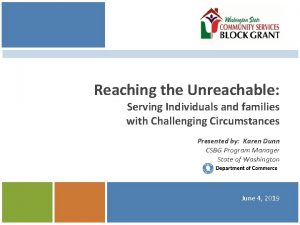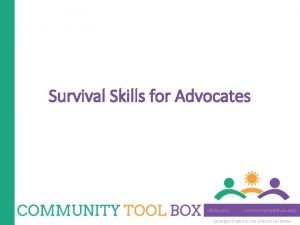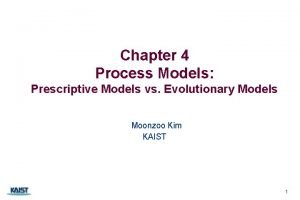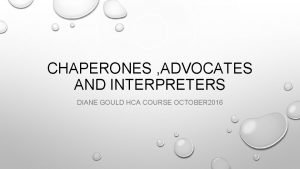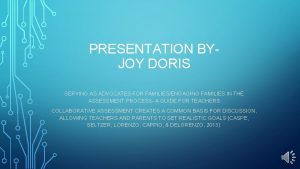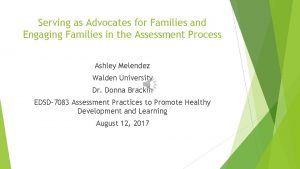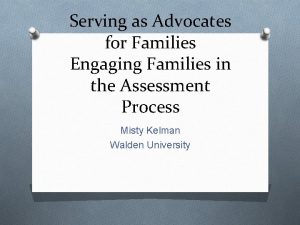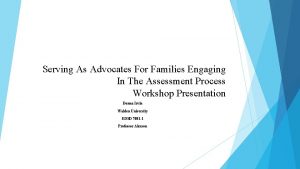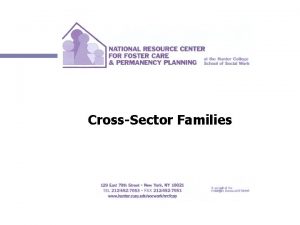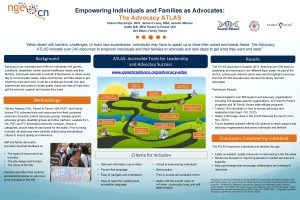Serving as Advocates for FamiliesEngaging Families in the









- Slides: 9

Serving as Advocates for Families/Engaging Families in the Assessment Process By Madeline Bevineau

Assessments � � � Assessment is an integral part of instruction, as it determines whether or not the goals of education are being met. Assessment affects decisions about grades, placement, advancement, instructional needs, and curriculum (Dann, 2012). Changes in the skills and knowledge of students require new learning goals; these new learning goals change the relationship between assessment and instruction. Teachers and other early childhood staff can use assessment information to help families understand their child’s progress and explore new ideas for supporting their child’s learning and development at home and in the community.

Primary Grades The data can be used for different purposes, such as supporting family engagement, helping directors and policy councils make decisions, identifying appropriate curriculum supports, choosing topics for parenting workshops, and measuring child progress toward shared goals (Bryan & Henry, 2012). � � Assessments are meaningful sources of information for teachers, helping them identify what they taught well and what they need to work on. Assessment determines whether or not the goals of education are being met. Also, assessments in the primary grades allow for developing ideas for re-teaching and enrichment activities for teachers. When students are actively involved in assessing their own learning, next steps and creating goals to accomplish them, they make major advances in directing their learning and what they understand about themselves as learners. Assessments allow students the opportunity to reflect on where their learning is at and what needs to be done to achieve their learning goals.

Family Involvement Family involvement contributes significantly to the academic success of students. � � � Involving students and families in assessment can be a powerful way to encourage student ownership and responsibility for classroom work. By connecting student’s work in the classroom to their homework, involving families in assessment validates and supports home learning whether in school experiences, homework, or other formal or informal educational activities (Bryan & Henry, 2012). Supports a partnership of acknowledging opportunities for slowing down and thinking about what has taken place at school or at home helps students to focus on their goals for learning, on what they have done well, and on what they need to continue to work on the next day.

Family Information Teachers may need to collect data from parents or family members for the purposes of assessment or evaluation. � � Collaboration of stakeholders can inform evaluation goals, methods and measures to ensure they are relevant to the cultural context of participants. Also ensures that the assessment or evaluation is not dominated by a narrow viewpoint. Cultural competence in evaluation will ensure that the processes of data collection is ethical and respectful of participants needs and experiences. Being heard is a key building block of social inclusion initiatives, therefore by asking parents and children for their perspectives child and family services are enabling them to participate and be connected to their community (Caspe, Seltzer, Kennedy, Cappio, De. Lorenzo, 2013). When comparing environments, children will respond differently depending upon the environment in which they are interviewed verses a natural environment.

Communicate Results of Assessments Talking with parents about results is an opportunity to help them understand the role assessment plays in student learning. � � � Explain how you will use the assessment results to improve their child’s performance, and how the school or district will use the information. Describe the tests being used in your classroom and how they differ from each other. Show their child’s learning progress, as indicated by both assessment and classroom observation. Point out academic strengths and weaknesses, and what steps parents can take to address areas of concern. Answer any questions about the testing process and how it impacts the teaching process

Supporting Diversity and Multiculturalism Since today’s classroom is diverse, there is an increased emphasis to have all students reach the same academic goals and standards. Teacher play a significant role in seeking alternative ways to address various levels of knowledge with their students, especially forms of knowledge that marginalize certain groups while privileging others (2013). � � � Access to a general education curriculum should include support; particularly important in the content area because most students with disabilities will be held to the same educational standards as their peers without disabilities. Students bring levels of knowledge to their school, and, recognizing this, teachers and stakeholder must incorporate this knowledge and experience into classroom practice. Teachers and stakeholders must be willing to cross traditional personal and professional boundaries in pursuit of equality for all students.

Conclusion Meaningful family engagement in the primary grades continues to support school readiness and later academic success. Parental involvement is a critical element of the assessment process in early childhood education (Seefeldt, 2002). A child’s progress can be tied to classroom activities and home activities, development and learning are strongly reinforced and further family involvement is encouraged. Changes in a child’s academic skills can open a dialogue about the child’s strengths, opportunities for families and teachers. Then families and teachers can work in partnership to ensure that child continues to receive appropriate instruction and related experiences to further their development.

References � Bryan, J. , & Henry, L. (2012). A model for building school–family–community partnerships: Principles and process. Journal of Counseling & Development, 90(4), 408 -420. � Caspe, M. , Seltzer, A. , Kennedy, J. L. , Cappio, M. , & De. Lorenzo, C. (2013). Engaging families in the child assessment process. Young Children, 68(3), 8– 14. assessment as learning: Improving the learning process. Routledge. � Dann, R. (2012). Promoting � Mc. Caleb, S. P. (2013). Building communities of learners: A collaboration among teachers, students, families, and community. Routledge. � Carol Vincent Research Fellow in Education Policy. (2013). Parents and teachers: Power and participation. Routledge. � Seefeldt, C. (2002). Assessment: Partnering with parents. Scholastic Early Childhood Today, 17(1), 15– 18.
 Serving individuals and families
Serving individuals and families Serving individuals and families
Serving individuals and families Little families
Little families Early ob advocates
Early ob advocates Survival skills for advocates
Survival skills for advocates It advocates orderly approach to software engineering
It advocates orderly approach to software engineering Khurana & khurana advocates and ip attorneys (delhi branch)
Khurana & khurana advocates and ip attorneys (delhi branch) Goggletranslate
Goggletranslate Khurana & khurana advocates and ip attorneys
Khurana & khurana advocates and ip attorneys Housing land advocates
Housing land advocates

